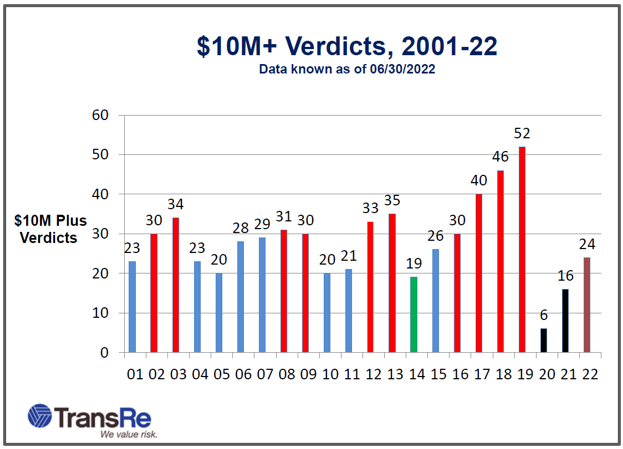How to Protect Your Organization From Excess Malpractice Verdicts
Litigation drags on in the face of unreasonable settlement demands
A 40-year-old woman was evaluated in the emergency department (ED) of her local hospital for abdominal pain. She underwent an abdominal CT scan during which she had a reaction to the contrast dye and died as a result. Her family filed a wrongful death malpractice lawsuit against the hospital alleging that the ED physician did not administer Epinephrine in a timely manner, thereby leading to her death.
After an expert review of the case determined that the ED physician did not meet the standard of care, Constellation and the ED physician sought to do the right thing by settling the case and compensating the family. Constellation valued the lawsuit at approximately $2M-$3M.

As part of the lawsuit, Constellation disclosed that the defendant ED physician had policy limits of $21M. The plaintiff’s (family) attorney then demanded $21M in settlement based solely on the policy limits and not on what was needed to compensate the family fairly.
Constellation later determined that the ED physician had additional coverage and policy limits were actually $37M. That same day, the plaintiff rescinded their $21M demand and made a “full policy limits demand” of $37M. Despite best efforts, a reasonable resolution could not be reached. After two years of litigation, the case proceeded to trial where the jury returned a verdict of $29.5M (later settled at $15M).
Recent years have shown an increase in large medical professional liability (malpractice) verdicts across the country. In addition, plaintiff settlement demands are on the rise—often driven by the limits of liability carried by the defendant instead of what is needed to compensate the patient or senior living resident for their injuries. Constellation’s verdict protection coverage through Excess Judgment Liability can help health care professionals, hospitals and senior living facilities optimize their risk management portfolio.
Higher verdicts are on the rise
Based on national research by Transatlantic Reinsurance Company (TransRe), 2019 set a record for jury verdicts of $10M or more at 52. Although the verdict amount rarely equals the ultimate indemnity payment, prior jury verdicts can influence future jury perception. Verdicts are a barometer that plaintiff and defense counsel utilize to determine if their respective theories of liability, causation and damages resonate with a jury or judge. As such, paying attention to jury verdicts is important.

By purchasing coverage specifically designed for unexpected large jury verdicts, health care teams are protected in the event of an unexpectedly high verdict in today’s increasingly litigious environment.
Policy limits can drive large settlement demands
Purchasing sufficient limits of liability within an insurance program is important, and plaintiffs are entitled to know of all limits applicable to their claim. However, the amount of limits purchased can often become a target for plaintiff attorneys, who become focused on policy limits instead of the true value of patient or senior living resident injuries. In this case above, the demand went from $21M to $37M based on the plaintiff attorney’s knowledge of available insurance coverage. Neither demand had any relation to the fair and reasonable amount to compensate the patient’s family. This is an example of how policy limits drive settlement demands.
Verdict protection coverage with Excess Judgment Liability allows health care teams to maintain more reasonable primary limits, which can enable faster resolution of harm events during settlement discussions. Coverage is discoverable at the outset of a lawsuit like any other applicable coverage, but the limits are not available for settlement unless or until there is a final award, meaning pre-award settlement discussions are based on the patient injuries and not inflated by policy limits. Faster resolution means health care teams spend less time in limbo and more time focusing on their mission—providing high quality, empathetic care to their patients.
Constellation’s verdict protection coverage
Constellation offers verdict protection coverage through Excess Judgment Liability coverage (sometimes referred to as “XJL”). It is insurance coverage that will apply in excess of other professional liability insurance purchased through a Constellation company. Although the coverage is discoverable like traditional limits, it is not accessible until a judgment is awarded through a jury verdict or binding arbitration.
Health care teams use verdict protection coverage through an Excess Judgment Liability policy to:
- Purchase reasonable primary limits: The risk of a large jury award has caused health care risk leaders to increase their primary malpractice limits which, in turn, can inadvertently invite even higher demands. Excess Judgment Liability coverage protects health care teams from inflated and unsubstantiated settlement demands.
- Continue providing excellent care after an adverse outcome: When health care professionals carry a reasonable primary limit, settlement discussions are much more likely to proceed quickly and fairly. This means more peace of mind for clinicians, less time away from work, and reduced stress when adverse outcomes do occur.
- Have peace of mind in a litigious environment: Constellation’s companies maintain high trial win rates, but juries are unpredictable. Excess Judgment Liability coverage provides health care professionals protection in the event of a judgment that exceeds the underlying policy limits.
With the rise of excess verdicts and inflated settlement demands, it could be a good time to have a discussion with your agent or broker about how to best structure policy limits in order to protect your organization.
Whether a harm event is resolved through a settlement or goes to trial, Constellation is in your corner and be assured we are here to defend your good medicine.
Share this blog article:
Latest Blog Articles
Five Steps to Reduce Generative AI Risks in Healthcare
AI is already assisting physicians and healthcare organizations in many ways. Learn how its use may impact liability and what strategies can mitigate risk.
Five Steps to Reduce Obstetrical Errors and Malpractice Claims
Learn how to reduce obstetrical harm using evidence-based protocols for managing high-risk situations, joint team fetal monitoring education, and enhanced teamwork.
How to Reduce Surgical Harm and Malpractice Claims
In an analysis of our medical professional liability claims, surgical allegations are #1 in occurrence and #2 in cost. Learn how to reduce surgical malpractice risk.
